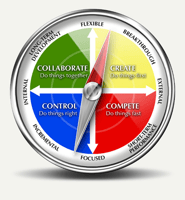What sort of Culture Champion are you? Let’s explore:
Tackling Burnout with Empathy: A Culture Leader's Guide
Imagine this: You're leading a team meeting, and as you scan the virtual room, you notice James, always the most animated of the group, is unusually quiet today. His camera is off, which is rare. When he does speak, his usual vibrancy is missing. This isn't the first time you've observed this change in one of your team members recently. As a leader, it's a red flag, signaling not just individual fatigue but a potential onset of team-wide burnout.
Burnout has become the boogeyman of the modern workplace, lurking in the shadows of high aspirations and relentless work ethics. In our recent Culture Labs Podcast, Dan met with Acey Holmes, a former clinical practitioner turned culture leader. Acey’s approach shines a light on this issue, unpacking how the neuroscience of play can help leaders grow in empathy and foster a culture that stops burnout before it begins. Acey’s approach is grounded in an understanding that behind every case of burnout is a brain craving relief from stress and a heart seeking understanding.
Too often, leaders can spend all their energy dealing with the symptoms of burnout without addressing the root culture that might be causing it. There is a better way to foster a healthy community at work; let’s explore how we can do that.
The Missteps in Addressing Burnout
Often, our first instinct to tackle burnout is to introduce more—more breaks, more team-building activities, and even more incentives. Yet, without empathy and understanding, these well-intentioned solutions can miss the mark. However, employee burnout is less about the workload itself and more about feeling undervalued, isolated, or misaligned with the work's purpose. Simply adding more to an already overwhelmed employee's plate, even if it's in the name of fun or relaxation, won't address the root problem.
The Empathy Approach
Empathy, as Holmes emphasizes, is about seeing the world through your team's eyes and feeling it with their hearts. It's recognizing that James's silence might be more than just a bad day—it could be a cry for help. Tackling burnout with empathy involves:
- Listening Actively: Create safe spaces for your team to share their feelings and experiences. This doesn't mean formal meetings alone; it can be as simple as starting one-on-one check-ins with, "How are you really feeling today?"
- Understanding Individual Needs: Recognize that each team member has unique stressors and motivations. What rejuvenates one person might not work for another. This tailored approach shows your team that their individual well-being truly matters to you.
- Fostering a Culture of Play: “Play” is not always a word we hear thrown around the corporate office, but it is a great mindset to adopt to foster a healthy workplace culture. Acey’s concept of integrating play into work is not about forcing fun but about encouraging a mindset shift towards more enjoyable and engaging work processes. This could mean brainstorming sessions that start with the wildest ideas, celebrating failures as stepping stones to success, or simply injecting more creativity into everyday tasks.
Every Leader Can Try This
So what can we do on our teams to help our people feel connected to the community and the mission, preventing burnout and making work more enjoyable? Here are a few concrete steps you can begin now:
- Model Empathy and Vulnerability: Share your own experiences with stress and burnout. When leaders open up, it sets a tone of trust and openness in the team.
- Encourage Playful Work: Inspired by Holmes’s work, look for opportunities to make tasks more engaging. Can a routine project update become a storytelling session? Can problem-solving involve a virtual game that stimulates creative thinking?
- Regular Check-ins: Don’t wait for your team members to come to you with problems. Regular, informal check-ins can help you catch signs of burnout early and address them proactively.
- Education on Burnout: Use resources like the Instill Culture Vital Signs™ to educate your team on recognizing and managing burnout. Knowledge is power, and understanding burnout can empower your team to take control of their well-being.
Burnout is complex, but with empathy and a strategic approach, it's not insurmountable. By leveraging empathetic leadership, you can transform your workplace culture from one that merely manages burnout to one that actively prevents it. Once burnout takes root, it is much harder to reverse course.
At Instill, we recognize the critical nature of managing burnout, which is why we've identified it as a crucial Vital Sign for leaders to monitor. Our AI-driven platform is designed to help you detect and address the early signs of burnout, ensuring your team remains vibrant, engaged, and productive. The ultimate goal transcends beyond merely facilitating work; it's about nurturing a workspace where every individual feels valued, seen, and passionately engaged — a definitive win-win for everyone involved.




Blog comments